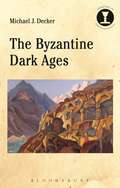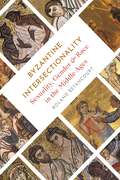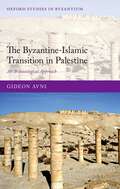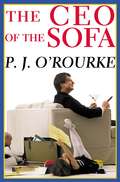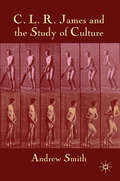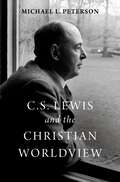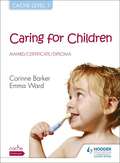- Table View
- List View
Byzantine Constantinople: Monuments, Topography and Everyday Life (PDF) (The Medieval Mediterranean #33)
by Nevra NecipogluThis collection of papers on the city of Constantinople by a distinguished group of Byzantine historians, art historians, and archaeologists provides new perspectives as well as new evidence on the monuments, topography, social and economic life of the Byzantine imperial capital.
The Byzantine Dark Ages (Debates in Archaeology)
by Michael J. DeckerThe Byzantine Dark Ages explores current debates about the sudden transformation of the Byzantine Empire in the wake of environmental, social and political changes. Those studying the Byzantine Empire, the successor to the Roman Empire in the eastern Mediterranean, have long recognized that the mid-7th century CE ushered in sweeping variations in the way of life of many inhabitants of the Mediterranean world, with evidence of the decline of the size and economic prosperity of cities, a sharp fall in expressions of literary culture, the collapse in trade networks, and economic and political instability.Michael J. Decker looks at the material evidence for the 7th to 9th centuries, lays out the current academic discourse about its interpretation, and suggests new ways of thinking about this crucial era. Important to readers interested in understanding how and why complex societies and imperial systems undergo and adapt to stresses, this clearly written, accessible work will also challenge students of archaeology and history to think in new ways when comprehending the construction of the past.
The Byzantine Dark Ages (Debates in Archaeology)
by Michael J. DeckerThe Byzantine Dark Ages explores current debates about the sudden transformation of the Byzantine Empire in the wake of environmental, social and political changes. Those studying the Byzantine Empire, the successor to the Roman Empire in the eastern Mediterranean, have long recognized that the mid-7th century CE ushered in sweeping variations in the way of life of many inhabitants of the Mediterranean world, with evidence of the decline of the size and economic prosperity of cities, a sharp fall in expressions of literary culture, the collapse in trade networks, and economic and political instability.Michael J. Decker looks at the material evidence for the 7th to 9th centuries, lays out the current academic discourse about its interpretation, and suggests new ways of thinking about this crucial era. Important to readers interested in understanding how and why complex societies and imperial systems undergo and adapt to stresses, this clearly written, accessible work will also challenge students of archaeology and history to think in new ways when comprehending the construction of the past.
Byzantine Intersectionality: Sexuality, Gender, and Race in the Middle Ages
by Roland BetancourtA fascinating history of marginalized identities in the medieval worldWhile the term “intersectionality” was coined in 1989, the existence of marginalized identities extends back over millennia. Byzantine Intersectionality reveals the fascinating, little-examined conversations in medieval thought and visual culture around matters of sexual and reproductive consent, bullying and slut-shaming, homosocial and homoerotic relationships, trans and nonbinary gender identities, and the depiction of racialized minorities. Roland Betancourt explores these issues in the context of the Byzantine Empire, using sources from late antiquity and early Christianity up to the early modern period. Highlighting nuanced and strikingly modern approaches by medieval writers, philosophers, theologians, and doctors, Betancourt offers a new history of gender, sexuality, and race.Betancourt weaves together art, literature, and an impressive array of texts to investigate depictions of sexual consent in images of the Virgin Mary, tactics of sexual shaming in the story of Empress Theodora, narratives of transgender monks, portrayals of same-gender desire in images of the Doubting Thomas, and stereotypes of gender and ethnicity in representations of the Ethiopian Eunuch. He also gathers evidence from medical manuals detailing everything from surgical practices for late terminations of pregnancy to save a mother’s life to a host of procedures used to affirm a person’s gender.Showing how understandings of gender, sexuality, and race have long been enmeshed, Byzantine Intersectionality offers a groundbreaking look at the culture of the medieval world.
The Byzantine-islamic Transition In Palestine: An Archaeological Approach (Oxford Studies in Byzantium)
by Gideon AvniUsing a comprehensive evaluation of recent archaeological findings, Avni addresses the transformation of local societies in Palestine and Jordan between the sixth and eleventh centuries AD. Arguing that these archaeological findings provide a reliable, though complex, picture, Avni illustrates how the Byzantine-Islamic transition was a much slower and gradual process than previously thought, and that it involved regional variability, different types of populations, and diverse settlement patterns. Based on the results of hundreds of excavations, including Avni's own surveys and excavations in the Negev, Beth Guvrin, Jerusalem, and Ramla, the volume reconstructs patterns of continuity and change in settlements during this turbulent period, evaluating the process of change in a dynamic multicultural society and showing that the coming of Islam had no direct effect on settlement patterns and material culture of the local population. The change in settlement, stemming from internal processes rather than from external political powers, culminated gradually during the Early Islamic period. However, the process of Islamization was slow, and by the eve of the Crusader period Christianity still had an overwhelming majority in Palestine and Jordan.
Byzantine Media Subjects (Medieval Societies, Religions, and Cultures)
by Glenn A. PeersByzantine Media Subjects invites readers into a world replete with images—icons, frescoes, and mosaics filling places of worship, politics, and community. Glenn Peers asks readers to think themselves into a world where representation reigned and humans followed, and indeed were formed. Interrogating the fundamental role of representation in the making of the Byzantine human, Peers argues that Byzantine culture was (already) posthuman. The Byzantine experience reveals the extent to which media like icons, manuscripts, music, animals, and mirrors fundamentally determine humans. In the Byzantine world, representation as such was deeply persuasive, even coercive; it had the power to affect human relationships, produce conflict, and form self-perception. Media studies has made its subject the modern world, but this book argues for media having made historical subjects. Here, it is shown that media long ago also made Byzantine humans, defining them, molding them, mediating their relationship to time, to nature, to God, and to themselves.
Byzantine Tree Life: Christianity and the Arboreal Imagination (New Approaches to Byzantine History and Culture)
by Thomas Arentzen Virginia Burrus Glenn PeersThis book examines the many ways Byzantines lived with their trees. It takes seriously theological and hagiographic tree engagement as expressions of that culture’s deep involvement—and even fascination—with the arboreal. These pages tap into the current attention paid to plants in a wide range of scholarship, an attention that involves the philosophy of plant life as well as scientific discoveries of how communicative trees may be, and how they defend themselves. Considering writings on and images of trees from Late Antiquity and medieval Byzantium sympathetically, the book argues for an arboreal imagination at the root of human aspirations to know and draw close to the divine.
Byzantium in the Popular Imagination: The Modern Reception of the Byzantine Empire (New Directions in Byzantine Studies)
by Markéta Kulhánková and Przemysław MarciniakWhat is the contemporary cultural legacy of Byzantium or The Eastern Roman Empire? This book explores the varied reception history of the Byzantine Empire across a range of cultural production.Split into four sections: the origins of 'Byzantomania' in France, modern media, literature, and politics, it provides case studies which show the numerous ways in which the empire's legacy can be felt today. Covering television, video games and contemporary political discourse, contributors also consider a wide range of national and geographical perspectives including Russian, Turkish, Polish, Greek and Hungarian. It will be essential reading for scholars and students of the reception and cultural history of the Byzantine Empire.
Byzantium in the Popular Imagination: The Modern Reception of the Byzantine Empire (New Directions in Byzantine Studies)
What is the contemporary cultural legacy of Byzantium or The Eastern Roman Empire? This book explores the varied reception history of the Byzantine Empire across a range of cultural production.Split into four sections: the origins of 'Byzantomania' in France, modern media, literature, and politics, it provides case studies which show the numerous ways in which the empire's legacy can be felt today. Covering television, video games and contemporary political discourse, contributors also consider a wide range of national and geographical perspectives including Russian, Turkish, Polish, Greek and Hungarian. It will be essential reading for scholars and students of the reception and cultural history of the Byzantine Empire.
The C.E.O. of the Sofa: From bestselling political humorist P.J.O'Rourke
by P. J. O'RourkeIn The CEO of the Sofa, P. J. tackles everything and the kitchen sink, fighting evil, injustice, and absurdity with the gloves off and the oven mitts on.New York Times best-selling author P. J. O'Rourke lobbed one-liners on the battlefields of the Gulf War, traded quips with communist rebels in the jungles of the Philippines, and went undercover at the Dome of the Rock Mosque as P. .J. of Arabia. Now, in his most challenging adventure, he journeys to the heart of that truly harrowing place-his living room. He waxes cynical over the election of Hillary Clinton. He waxes nostalgic over learning to drive. He waxes poetic as he adds happy endings for liberals to famous tragedies. Now if he would just wax the kitchen floor. And P. J. does still get off the couch and embark on exotic adventures-to the magical land of India, to the U. N. Millennial Summit, to a blind (drunk) wine tasting with Christopher Buckley, and, most exotical of all, to a Motel 6 where he has twenty-eight channels and a bathroom to himself.
C. Henry Kempe: A 50 Year Legacy to the Field of Child Abuse and Neglect (Child Maltreatment #1)
by Richard D. Krugman and Jill E. KorbinThe book series, “Child Maltreatment: Contemporary Issues in Research and Policy.” will consist of a state of the art handbook (to be revised every five years) and two to three volumes per year. The first volume in this series is a legacy to C. Henry Kempe. This is a timely publication because 2012 marks 50 years after the appearance of the foundational article by C. Henry Kempe and his colleagues, “The Battered-Child Syndrome.” This volume capitalizes on this 50 year anniversary to stand back and assess the field from the perspective that Dr. Kempe’s early contributions and ideas are still being played out in practice and policy today. The volume will be released at the next ISPCAN meeting, also in 2012.
C.L.R. James and the Study of Culture
by A. SmithThis book provides the first dedicated introduction to the cultural writings and analyses of the radical West Indian thinker C.L.R. James. It lays out James' account of the way in which games, books, music and film become a part of the politics and history of popular struggles.
C.P. Snow: The Dynamics of Hope
by N. TredellNovelist and cultural commentator C.P. Snow was a large and controversial presence in his lifetime but his work has been largely neglected since his death in 1980. This is the first 21st-century book to offer a clear, informed and sympathetic survey of all his novels and major non-fiction books and to affirm their importance for the world today.
C. S. Lewis and the Christian Worldview
by Michael L. PetersonC. S. Lewis is one of the most influential and beloved Christian writers of the past century, and interest in him continues to grow as books about his fantasy, fiction, and biography continue to appear. Although Lewis's personal journey was a deeply philosophical search for the most adequate worldview, the few extant books about his Christian philosophy focus on specific topics rather than his overall worldview. In this book, Michael Peterson develops a comprehensive framework for understanding Lewis's Christian worldview--from his arguments from reason, morality, and desire to his ideas about Incarnation, Trinity, and Atonement. All worldviews address fundamental questions about reality, knowledge, human nature, meaning, and so forth. Peterson therefore examines Lewis's Christian approach to these same questions in interaction with other worldviews. Accenting that the intellectual strength and existential relevance of Lewis's works rest on his philosophical acumen as well as his Christian orthodoxy--which he famously called "mere Christianity"--Peterson skillfully shows how Lewis's Christian thought engages a variety of important problems raised by believers and nonbelievers alike: the problem of evil and suffering, the problem of religious diversity, the problem of meaning, and others. Just as Lewis was gifted in communicating philosophical ideas and arguments in an accessible style, Peterson has crafted a major contribution to Lewis scholarship presented in a way that will interest scholars and benefit the general reader.
C. S. Lewis and the Christian Worldview
by Michael L. PetersonC. S. Lewis is one of the most influential and beloved Christian writers of the past century, and interest in him continues to grow as books about his fantasy, fiction, and biography continue to appear. Although Lewis's personal journey was a deeply philosophical search for the most adequate worldview, the few extant books about his Christian philosophy focus on specific topics rather than his overall worldview. In this book, Michael Peterson develops a comprehensive framework for understanding Lewis's Christian worldview--from his arguments from reason, morality, and desire to his ideas about Incarnation, Trinity, and Atonement. All worldviews address fundamental questions about reality, knowledge, human nature, meaning, and so forth. Peterson therefore examines Lewis's Christian approach to these same questions in interaction with other worldviews. Accenting that the intellectual strength and existential relevance of Lewis's works rest on his philosophical acumen as well as his Christian orthodoxy--which he famously called "mere Christianity"--Peterson skillfully shows how Lewis's Christian thought engages a variety of important problems raised by believers and nonbelievers alike: the problem of evil and suffering, the problem of religious diversity, the problem of meaning, and others. Just as Lewis was gifted in communicating philosophical ideas and arguments in an accessible style, Peterson has crafted a major contribution to Lewis scholarship presented in a way that will interest scholars and benefit the general reader.
C. Wright Mills and the Criminological Imagination: Prospects for Creative Inquiry (Classical and Contemporary Social Theory)
by Jon FrauleyIn spite of its widespread use within criminology, the term ’criminological imagination’, as derived from C. Wright Mills’ classic The Sociological Imagination, has yet to be fully developed and clarified as an analytic concept capable of guiding theorizing or empirical enquiry. This volume, with a preface by Elliot Currie, engages with and reflects on this concept, exploring C. Wright Mills’ work for criminological enquiry. Bringing together the latest work of leading scholars in the fields of criminology and sociology from around the world, C. Wright Mills and the Criminological Imagination investigates the emergence and lineage of a criminological concept indebted to Mills’ thought, adapting and applying it to a specifically criminological context. With attention to theoretical concerns and, as well as the application of the criminological imagination in concrete empirical research, this volume sheds new light on the methodological and analytical aspects of the criminological imagination as a multifaceted concept and explores the possibilities that it offers for the emergence of an imaginative criminological practice. As such, it will appeal to scholars across the social sciences with interests in sociology and social theory, criminology, criminal justice studies, law and research methods.
C. Wright Mills and the Criminological Imagination: Prospects for Creative Inquiry (Classical and Contemporary Social Theory)
by Jon FrauleyIn spite of its widespread use within criminology, the term ’criminological imagination’, as derived from C. Wright Mills’ classic The Sociological Imagination, has yet to be fully developed and clarified as an analytic concept capable of guiding theorizing or empirical enquiry. This volume, with a preface by Elliot Currie, engages with and reflects on this concept, exploring C. Wright Mills’ work for criminological enquiry. Bringing together the latest work of leading scholars in the fields of criminology and sociology from around the world, C. Wright Mills and the Criminological Imagination investigates the emergence and lineage of a criminological concept indebted to Mills’ thought, adapting and applying it to a specifically criminological context. With attention to theoretical concerns and, as well as the application of the criminological imagination in concrete empirical research, this volume sheds new light on the methodological and analytical aspects of the criminological imagination as a multifaceted concept and explores the possibilities that it offers for the emergence of an imaginative criminological practice. As such, it will appeal to scholars across the social sciences with interests in sociology and social theory, criminology, criminal justice studies, law and research methods.
C. Wright Mills and the Ending of Violence
by J. BrewerThis book has two aims: to clarify the meaning of C. Wright Mills's depiction of the sociological imagination; and to use this to develop a sociological framework that assists in understanding the process by which communal violence has ended in Northern Ireland and South Africa. The contrast between these two societies is a familiar one, but the book is novel by developing an explanatory framework based on Mills's 'sociological imagination'. This model merges developments in the two countries at the individual, social structural and political arenas in order to account for the emergence of their peace processes.
C2 Re-envisioned: The Future of the Enterprise
by Marius S. Vassiliou David S. Alberts Jonathan Russell AgreCommand and Control (C2) is the set of organizational and technical attributes and processes by which an enterprise marshals and employs human, physical, and information resources to solve problems and accomplish missions.C2 Re-envisioned: The Future of the Enterprise identifies four interrelated megatrends that are individually and collectively sh
A Cabinet of Byzantine Curiosities: Strange Tales and Surprising Facts from History's Most Orthodox Empire
by Anthony KaldellisWeird, decadent, degenerate, racially mixed, superstitious, theocratic, effeminate, and even hyper-literate, Byzantium has long been regarded by many as one big curiosity. According to Voltaire, it represented "a worthless collection of miracles, a disgrace for the human mind"; for Hegel, it was "a disgusting picture of imbecility." A Cabinet of Byzantine Curiosities will churn up these old prejudices, while also stimulating a deeper interest among readers in one of history's most interesting civilizations. Many of the zanier tales and trivia that are collected here revolve around the political and religious life of Byzantium. Thus, stories of saints, relics, and their miracles-from the hilarious to the revolting-abound. Byzantine bureaucracy (whence the adjective "Byzantine"), court scandals, and elaborate penal code are world famous. And what would Byzantium be without its eunuchs, whose ambiguous gender produced odd and risible outcomes in different contexts? The book also contains sections on daily life that are equally eye-opening, including food (from aphrodisiacs to fermented fish sauce), games such as polo and acrobatics, and obnoxious views of foreigners and others (e.g., Germans, Catholics, Arabs, dwarves). But lest we overlook Byzantium's more honorable contributions to civilization, also included are some of the marvels of Byzantine science and technology, from the military (flamethrowers and hand grenades) to the theatrical ("elevator" thrones, roaring mechanical lions) and medical (catheters and cures, some bizarre). This vast assortment of historical anomaly and absurdity sheds vital light on one of history's most obscure and orthodox empires.
A Cabinet of Byzantine Curiosities: Strange Tales and Surprising Facts from History's Most Orthodox Empire
by Anthony KaldellisWeird, decadent, degenerate, racially mixed, superstitious, theocratic, effeminate, and even hyper-literate, Byzantium has long been regarded by many as one big curiosity. According to Voltaire, it represented "a worthless collection of miracles, a disgrace for the human mind"; for Hegel, it was "a disgusting picture of imbecility." A Cabinet of Byzantine Curiosities will churn up these old prejudices, while also stimulating a deeper interest among readers in one of history's most interesting civilizations. Many of the zanier tales and trivia that are collected here revolve around the political and religious life of Byzantium. Thus, stories of saints, relics, and their miracles-from the hilarious to the revolting-abound. Byzantine bureaucracy (whence the adjective "Byzantine"), court scandals, and elaborate penal code are world famous. And what would Byzantium be without its eunuchs, whose ambiguous gender produced odd and risible outcomes in different contexts? The book also contains sections on daily life that are equally eye-opening, including food (from aphrodisiacs to fermented fish sauce), games such as polo and acrobatics, and obnoxious views of foreigners and others (e.g., Germans, Catholics, Arabs, dwarves). But lest we overlook Byzantium's more honorable contributions to civilization, also included are some of the marvels of Byzantine science and technology, from the military (flamethrowers and hand grenades) to the theatrical ("elevator" thrones, roaring mechanical lions) and medical (catheters and cures, some bizarre). This vast assortment of historical anomaly and absurdity sheds vital light on one of history's most obscure and orthodox empires.
Cabinets, Ministers, and Gender
by Claire Annesley Karen Beckwith Susan FranceschetHistorically, men have been more likely to be appointed to governing cabinets, but gendered patterns of appointment vary cross-nationally, and women's inclusion in cabinets has grown significantly over time. This book breaks new theoretical ground by conceiving of cabinet formation as a gendered, iterative process governed by rules that empower and constrain presidents and prime ministers in the criteria they use to make appointments. Political actors use their agency to interpret and exploit ambiguity in rules to deviate from past practices of appointing mostly men. When they do so, they create different opportunities for men and women to be selected, explaining why some democracies have appointed more women to cabinet than others. Importantly, this dynamic produces new rules about women's inclusion and, as this book explains, the emergence of a concrete floor, defined as a minimum number of women who must be appointed to a cabinet to ensure its legitimacy. Drawing on in-depth analyses of seven countries (Australia, Canada, Chile, Germany, Spain, the United Kingdom, and the United States) and elite interviews, media data, and autobiographies of cabinet members, Cabinets, Ministers, and Gender offers a cross-time, cross-national study of the gendered process of cabinet formation.
Cabinets, Ministers, and Gender
by Susan Franceschet Karen Beckwith Claire AnnesleyHistorically, men have been more likely to be appointed to governing cabinets, but gendered patterns of appointment vary cross-nationally, and women's inclusion in cabinets has grown significantly over time. This book breaks new theoretical ground by conceiving of cabinet formation as a gendered, iterative process governed by rules that empower and constrain presidents and prime ministers in the criteria they use to make appointments. Political actors use their agency to interpret and exploit ambiguity in rules to deviate from past practices of appointing mostly men. When they do so, they create different opportunities for men and women to be selected, explaining why some democracies have appointed more women to cabinet than others. Importantly, this dynamic produces new rules about women's inclusion and, as this book explains, the emergence of a concrete floor, defined as a minimum number of women who must be appointed to a cabinet to ensure its legitimacy. Drawing on in-depth analyses of seven countries (Australia, Canada, Chile, Germany, Spain, the United Kingdom, and the United States) and elite interviews, media data, and autobiographies of cabinet members, Cabinets, Ministers, and Gender offers a cross-time, cross-national study of the gendered process of cabinet formation.
CACHE Level 1 Caring for Children Award, Certificate, Diploma (PDF)
by Corinne Barker Emma WardWritten by authors who have achieved considerable success in guiding students through Level 1 qualifications, this easy-to-read book includes simple language, colourful pages and lots of photographs. It carefully covers all of the content you need in order to finish the course and will help you through your assessment. Published in partnership with CACHE, this is the ideal textbook for you if you are taking the award, certificate or diploma in CACHE Level 1 Caring for Children.
CACHE Level 2 Award in Child Development and Care
by Penny Tassoni Louise BurnhamHelp students build knowledge and prepare for assessment with this essential classroom resource from Penny Tassoni and Louise Burnham - the only textbook tailored to the CACHE Level 2 Award in Child Development and Care.- Clearly defines 'High Priority' concepts the learner should take away from each section.- Shows how each topic is used in practice through 'Theory in Action' sections.- Explains each of the relevant grading criteria with reference to CACHE tasks.- Written by the highly experienced and expert author team of Penny Tassoni and Louise Burnham.

